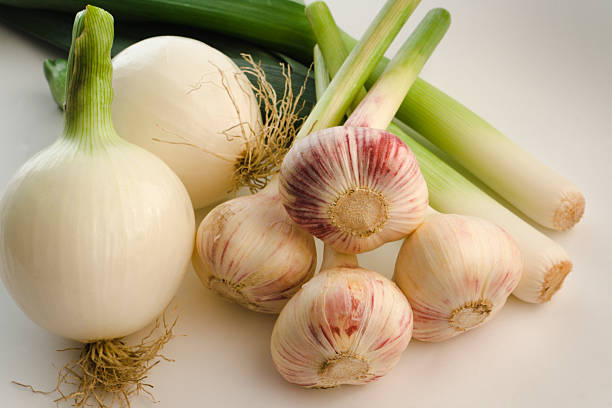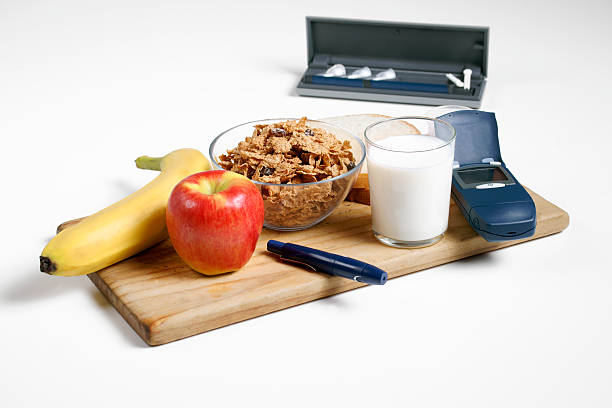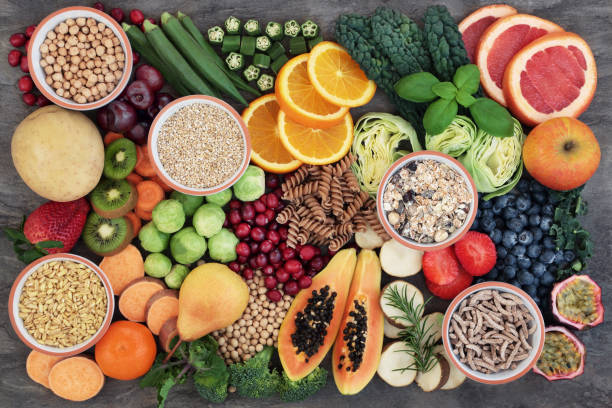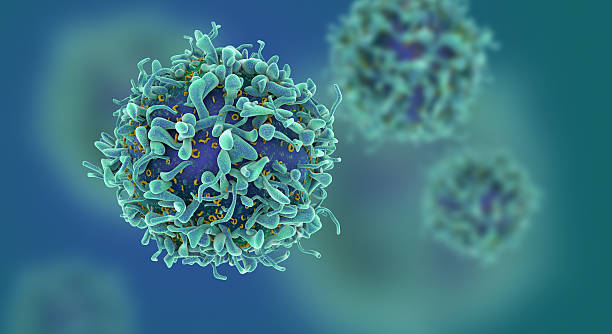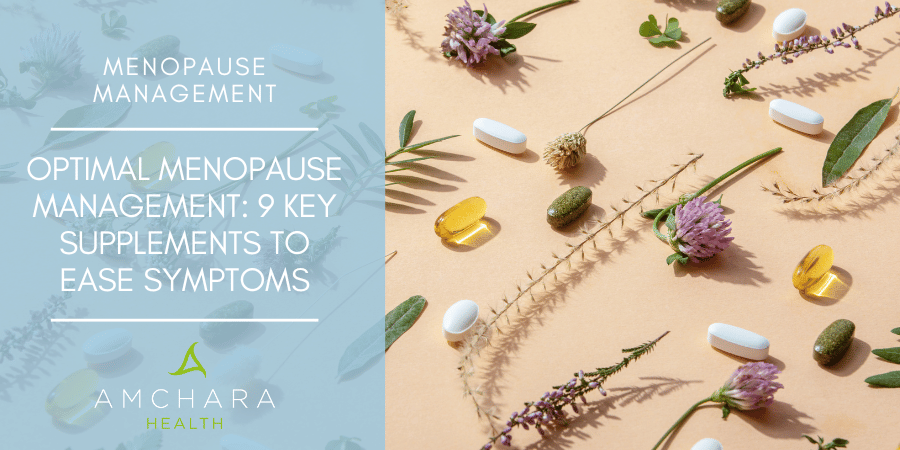Types of Fibre | Digestive Health | Examples of Fibre | How Much Fibre? | Free Consultation
Fibre is an essential part of a healthy diet. It helps to keep your digestive system in good working order and has many other important health benefits.
Fibre is found in many plant-based, carbohydrate-rich foods, such as nuts and seeds, potato skins, vegetables including green beans, celery, jerusalem artichokes, beans and peas, whole grain foods and some fruits including avocado and unripened bananas.
According to a study published in the Journals of Gerontology, (1) those who eat a fibre rich diet are 80 per cent more likely to live longer and stay healthier.
In this article we cover the following topics:
- Different types of fibre
- Fibre and your digestive health
- Fibre and sugar cravings
- Fibre and Type 2 Diabetes
- Fibre and weight loss
- Fibre and hormone balance
- Fibre and cancer risk
- How much fibre should you aim for?
- Table – Types of fibre and sources
- Table – Examples of fibre content of foods per 100g
Here are 7 ways to get more fibre into your diet:
Watch this short video by ‘The Protein Chef‘ on how to do this [2:57]
Dietary fiber is extremely important in everyone’s diet. So, here are 7 quick and cheap ways to some more fiber in your diet!
What is fibre and why is it so important?
Fibre is a type of indigestible carbohydrate and used to be known as ‘roughage’.
It has no nutritional value but the foods in which it is found contain many important nutrients such as vitamins, minerals, phytochemicals and antioxidants.
Fibre itself is a group of substances in plant foods which cannot be completely broken down by our own digestive enzymes.
It can be found in cereal grain foods such as bread – as well as pulses, beans, nuts, vegetables and fruit.
It was once thought that dietary fibre was completely indigestible and did not provide any energy.
However today we know that some fibre can be fermented in the large intestine by gut bacteria.
This process produces short chain fatty acids and gases (methane, hydrogen and carbon dioxide) that are absorbed by the blood and provide a small amount of energy.
The amount of gas produced varies depending on the choice of fibre ingested and your personal gut bacteria.
If you suddenly increase your fibre intake it is possible you may experience some discomfort, bloating and wind. However, your body will adapt to the increased intake and soon be able to tolerate fibre with fewer symptoms
Different types of fibre
In the simplest form fibre (carbohydrates) can be categorised as either soluble or insoluble although it is now believed there are at least 6 sub-categories of fibre.
Each plays a different yet equally important role in the body.
It should be noted that fibre rich foods contain both soluble and insoluble fibre.
For example, the skin of an apple contains insoluble fibre whereas the flesh of the apple contains soluble fibre.
# Soluble fibre
Soluble fibre dissolves in water forming a gloopy gel-like substance.
They bypass the digestion of the small intestine and are easily fermented by the microflora of the large intestine.
Soluble fibre is found in fresh fruit, oats and pulses and has been shown to restrict the amount of fat absorbed from food, significantly lowering total blood cholesterol levels whilst increasing HDL (good) cholesterol levels.
Soluble fibre is, therefore, a vital component of a well-rounded diet helping to support a healthy heart and arteries.
In addition to these soluble fibres such as those found in guar gum can slow down the absorption of sugar and consequently is often used for diabetics.
READ: How to get more fibre into your diet (NHS)
Non-digestible oligosaccharides
This type of soluble fibre also known as resistant starch or pre-biotics deserves a special mention because although it is resistant to the body’s own digestive enzymes it is later broken down by enzymes that are produced by bacteria inhabiting the colon.
This fermentation in the colon creates by-products that are extremely beneficial for the colon environment.
Natural pre-biotics such as inulin and oligofructose are stable and have long-lasting effects on the gut flora by encouraging the growth of healthy bacteria.
Furthermore, they also help to crowd out other bacteria that produce toxins and can cause disease if they grow unchecked.
Pre-biotic fibre is found mostly in vegetables like onions, leeks, chicory root, oats and Jerusalem artichoke.
The fresher the vegetable the higher it’s inulin content. Storage for long periods particularly in cold or cool environments dramatically reduces the pre-biotic content.
# Insoluble fibre
Insoluble fibres are not water soluble.
They do not form gels due to their water insolubility and fermentation is severally limited.
Some examples of insoluble fibre include lignin, cellulose and some hemicelluloses.
Raw vegetables and whole unrefined grains are a rich source of insoluble fibre.
These types of fibre pass undigested straight through the body.
They absorb water readily and help to bulk out the waste matter, stimulating the muscular contractions that are needed to push food steadily along the intestines.
The resulting stool formation should be large, soft, easy to eliminate and should float.
A lack of insoluble fibre in the diet combined with insufficient liquid results in small hard stools that are hard to pass and may cause constipation.
Waste matter accumulating in the bowel due to constipation can lead to infection and ill health.
Fibre and your digestive health
A fibre rich diet helps to maintain healthy bowel movement reducing the incidence of both constipation and diarrhoea.
Some types of fibre as mentioned above can be fermented by gut bacteria helping to maintain a healthily balanced gut flora as well as creating the correct pH (acidic) environment.
If you are low on pre-biotic fibre you are vulnerable to all kinds of gastrointestinal problems.
The older you are the fewer healthy bacteria you have in your gut. Furthermore, eating a diet low in fibre is associated with diverticulitis and bowel cancer.
Evidence suggests that maintaining a diet rich in fibre can offer a protective effect against both diseases.
READ: Your Ultimate High-Fiber Grocery List (WebMD)
Fibre and sugar cravings
Sugar consumption disturbs your blood sugar levels, e.g. when you eat highly refined sugary foods, it is released quickly into the blood as glucose giving a temporary high.
The pancreas releases insulin which lowers the glucose but often too low (a result of a high sugar diet), often leading to lethargy, lack of motivation, dizziness, weakness, fatigue and sometimes depression.
These symptoms trigger cravings for sugar which brings temporary relief and so the vicious cycle continues.
It is important that the sugar in foods is released gradually preventing sudden rushes of glucose, which reduces sugar cravings.
Fibre helps to do this by slowing down the absorption of glucose preventing see-sawing blood sugar levels as well keeping you full so there is less room for sugary refined foods.
Fibre and Type 2 Diabetes
Research has shown that dietary fibre improves glycaemic control and for this reason has an important role in managing diabetes.
Not only is there evidence that a diet high in fibre reduces the risk of developing type 2 diabetes, but studies have also found that higher intakes of cereal fibre and higher consumption of whole grains can lower the incidence of Type 2 Diabetes.
These benefits are thought to be because the short chain fatty acids produced during fermentation of fibre reduce the circulating free fatty acids as well as influencing the gut hormones that are involved in regulating blood glucose levels and body mass.
One study found there were significant reductions in glucose and insulin when fibre was added to a standard breakfast.
Fibre and weight loss
A diet rich in fibre is usually lower in fat and contains more starchy foods, fruit and vegetables.
Foods high in fibre tend to have a high volume and lower calorie content and require a lot more chewing.
Chewing for longer gives the brain time to register that you are no longer hungry and are therefore less likely to overeat.
Additionally, fibre rich foods absorb water and bulk out the stomach making you feel fuller so potentially may help to reduce hunger and control energy balance. Increased fibre intake can, therefore, bring about a reduction in the intake of other foods and a lower fat intake which can be useful for those who are overweight.
Studies have found (2) that fibre such as rice bran and oat bran can hinder both fat and glucose absorption. A daily dose of 20g/d has been seen to reduce overall body weight.
Fibre and hormone balance
Fibre helps to eliminate excess hormones and can promote oestrogen clearance.
Any excess oestrogen in the body is broken down in the liver and excreted via the bile out through the intestines. Fibre soaks up the bile and transports it out of the body.
If your diet is lacking in fibre and you have an abnormal gut flora the excess oestrogen can be re-absorbed back into the body increasing the oestrogen load and leading to hormonal imbalances.
Oestrogen dominance can cause several undesirable symptoms such as headaches, weight gain, allergies, sore breasts and fatigue.
It may also lead to further health complications such as endometriosis and polycystic ovaries.
Cancer researchers suggest that oestrogen dominance can leave you at greater risk of developing breast and ovarian cancer.
Including fibre rich foods like lentils, beans and chickpeas in your diet can also stimulate the release of a hormone known as Sex Hormone Binding Globulin.
This hormone is produced in the liver and will bind to sex hormones in the blood regulating their effect thereby helping to maintain effective hormone balance.
Fibre and cancer risk
Fibre is thought to reduce the risk of developing certain types of cancer.
According to scientists’ (3) dietary fibre resists digestion in the small intestine, which allows it to enter the large intestine where fermentation takes place by healthy bacteria.
These produce short-chain fatty acids, which are known to have anti-carcinogenic properties.
As well as this because fibre bulks out the stool and promotes bowel movement there is less contact time between potential carcinogens and the cells that line the colon.
Furthermore, it is thought that fibre increases the binding between bile acids and carcinogens.
Another anti-cancer benefit as mentioned above is that fibre increases the elimination of oestrogen in the faeces by inhibiting oestrogen absorption in the intestines.
How much fibre should you aim for?
Most people do not eat enough dietary fibre, on average men in the UK consume around 20g a day and women around 17g.
The most common form of dietary fibre consumed in Britain is sourced from cereals and cereal products such as bread, followed by potatoes and vegetables.
The minimum recommended average daily intake for fibre is 30g for adults.
There is no recommended upper limit.
Children need proportionally less – the recommended amounts are:
- 2-5 years – 15g/day
- 5-11 years, 20g/day
- 11-16 years 25g/day
- 16-18 years, 30g/day
It’s likely you are consuming enough fibre if you pass soft stools without straining at least once a day although 2-3 times a day is considered healthiest.
High intakes of dietary fibre may reduce absorption of some minerals from food as they are bound by the fibre in insoluble complexes.
Although some of the bound minerals i.e. calcium is released by fermentation in the colon.
Depletion of vitamins and minerals due to a high fibre diet is unlikely to be significant unless an individual’s diet is already poor.
A low fibre diet is potentially a greater risk to health than a very high fibre diet.
Table – Types of fibre and sources
| Fibre Component | Description | Food sources |
| Cellulose | Polysaccharides comprising
up to 10 000 closely packed glucose units arranged linearly. |
Grains, vegetables, fruit, nuts, cereal bran. |
| Hemicellulose | Polysaccharides containing sugars other than glucose. | Cereal grains, vegetables, fruit, legumes (for example: peas, beans, chick peas, lentils) and nuts. |
| Lignin | A non-carbohydrate
component associated with plant walls. |
Foods with a woody component, for example, celery and the outer layers of cereal grains. |
| Beta-glucans | Glucose polymers that (unlike cellulose) have a branched
structure |
Mainly found in cell wall of oats and barley. |
| Pectins | A non-starch polysaccharide common to all cell walls. | Fruits and vegetables, legumes, nuts and potatoes. |
| Gums and mucilages | Non-starch polysaccharides which are thick gel-forming
fibres that help hold plant cell walls together. |
Gums: seeds and seaweed extracts; Mucilages: psyllium seeds. Gums and mucilage are used as gelling agents, thickeners, stabilisers and emulsifying agents. |
| Resistant starch | Starch and the products of
starch digestion that is not absorbed by the small intestine. |
Legumes, potatoes, cereal grains |
| Oligosaccharides | Short chain carbohydrates of
3-9 monomers. These include fructo-oligosaccharides and galacto-oligosaccharides. |
Onions, chicory, Jerusalem artichokes |
| Micro components (waxes, cutin and suberin) | Micro components of the
plant structures. |
Cereal grains |
Examples of fibre content of foods per 100g
| Nuts | |
| Almonds | 14.3 |
| Fresh Coconut | 13.6 |
| Brazil | 9.0 |
| Peanuts | 8.1 |
| Grains | |
| Muesli | 7.4 |
| Boiled Rice – Brown | 5.5 |
| Soya flour | 14.3 |
| Wholemeal Bread | 6.5 |
| White Bread* | 2.2 |
| Shredded Wheat | 1.0 |
| Rice Crispies | |
| Oat Cakes | 4.0 |
| Rice bran (raw) | 21.0 |
| Legumes | |
| Baked Beans (canned) | 7.3 |
| Lentils (boiled) | 3.7 |
| Broad Beans | 4.2 |
| Peanut Butter | 7.6 |
| Vegetables | |
| Spinach | 6.3 |
| Steamed Broccoli | 4.1 |
| Raw Cabbage | 3.4 |
| Steamed Carrots | 3.1 |
| Raw Parsley | 9.1 |
| Peas (Raw or Fresh) | 5.2 |
| Potatoes in skins | 2 |
| Sweetcorn | 4.7 |
| Lettuce | 1.5 |
| Fruit | |
| Dried Raisins | 6.8 |
| Dried Figs | 18.5 |
| Loganberries | 6.2 |
| Raspberries | 7.4 |
| Dried Prunes | 16.1 |
| Bananas | 3.4 |
| Apples | 2 |
| Blackberries | 7.3 |
| * Note fibre decrease | |
It is clear that fibre is extremely important to overall health and hormone balance and can help you to live to a grand old age!
READ: Chart of high-fibre foods (MayoClinic)
The question is, are you getting enough?
If you’re not sure the table above gives a good indication of the foods that will give you the greatest level of fibre.
Try starting the day with a home-made muesli – throw in a good mix of coconut flakes, oats, dried fruits, nuts, seeds and fresh berries.
A jam-packed fibre and nutrient filled breakfast like this gives you a head start on your daily fibre needs and has the added benefit of keeping you going until lunchtime.
Related Articles You May Want To Read:
- 4 Ways to Help Your Digestive Health
- Supplement Guide to Female Hormone Health
- Could the FODMAP diet transform your life?
- Ditch the diet: discover the art of eating well
- 7 Reasons to choose a wheat-free diet
Sources
- Clayton P (2004). Health Defence 2nd edition. Accelerated Learning systems Ltd: Bucks UK.
- https://www.nutrition.org.uk/nutritionscience/nutrients-food-and-ingredients/dietary-fibre.html?start=4
- Gallo NB & Gerhardt AL. Full-Fat Rice Bran and Oat Bran Similarly Reduce Hypercholesterolemia in Humans, The Journal of Nutrition 1998; 128, I, 5: 865–869.
- Gopinath B et al. Association Between Carbohydrate Nutrition and Successful Aging Over 10 Years. The Journals of Gerontology, Series A: Biological Sciences and Medical Sciences. 2016 DOI: 10.1093/gerona/glw091.
- Haub MD & . Lattimer JM. Effects of Dietary Fiber and Its Components on Metabolic Health. Nutrients. 2010;2(12):1266-1289.
- Slavin J. Fiber and Prebiotics: Mechanisms and Health Benefits. Nutrients 2013; 5, 1417-1435.
- Tarini J & Wolver TMS Thomas M.S. The Fermentable fibre inulin increases postprandial serum short-chain fatty acids and reduces free-fatty acids and ghrelin in healthy subjects. Applied Physiology, Nutrition, and Metabolism, 2010, 35(1): 9-16.

